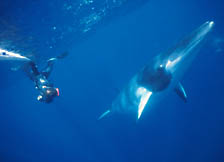
June 4, 2001
Scientists record extraordinary sounds made by minke whales
By Tim Stephens
When Jason Gedamke and Daniel Costa first went to Australia to record the sounds
of dwarf minke whales, people told them they were wasting their time. There were
very few reports of minke whale vocalizations, and some experts believed the species
rarely made any sounds at all. But according to Gedamke, a UCSC graduate student,
not only are minke whales vocal, their repertoire includes a loud
and distinctive songlike sequence unlike any previously recorded whale sound.
 |
| UCSC graduate student Jason Gedamke has a close encounter with a dwarf minke whale near Australia's Great Barrier Reef. Photo: Qamar Schuyler |
Neither could some whale experts he sent the recording to later, who suggested he check with the Australian Navy to find out if the noise was coming from their equipment. It turned out that Australian researchers had been hearing it for years and called it the "guitarfish" or "boingfish" sound, but had no idea what its source was. Gedamke calls it the "star-wars" vocalization; his logbook entry after first hearing the sound, which resembles a laser-gun sound effect, was simply "Star Wars!!??"
Gedamke and Costa, a professor of ecology and evolutionary biology, worked with Andy Dunstan, a scientist on the research and ecotourism vessel Undersea Explorer. They went to great lengths to demonstrate conclusively that the sound is made by dwarf minke whales. The researchers reported their findings in the June issue of the Journal of the Acoustic Society of America.
Their work was made easier by a remarkable population of dwarf minke whales that congregates from May to September on the northern part of Australia's Great Barrier Reef. These whales are unusually curious; when the Undersea Explorer stopped near them, they would approach to within a few yards and circle the boat and snorkeling observers for hours on end.
"There are other curious populations of whales, like the gray whales in Baja California, but there's really nothing else like this," Gedamke said. "We had 20 or more whales circling around the boat sometimes, and once they stayed with us for 11 hours."
To record and study the whales' vocalizations, the researchers used an array of hydrophones suspended in the water and marked with brightly colored floats so that observers in the water and on the boat could note the locations of whales relative to the hydrophones. Observers also took time-stamped underwater video of the whales for later comparison with the audio recordings. During three seasons in the field, from 1997 to 1999, Gedamke recorded 92 hours of whale sounds during 49 encounters.
Because the star-wars vocalization is so unique, researchers can now use it to learn more about dwarf minke whales. Minke whales are difficult to find in the open ocean because they produce small, inconspicuous blows when they surface to breathe. But now researchers can detect dwarf minkes using sensitive hydrophones to pick up the loud and distinctive star-wars vocalization.
"When you hear that sound, you know it's a minke whale, so we can use it to study their distribution, track their movements, and see how vocalizing animals are interacting with one another," Gedamke said.
There are several distinct forms of minke whales. The Northern Hemisphere and Southern Hemisphere forms are often considered separate species. The dwarf minke whale, although it occurs in the Southern Hemisphere, is more closely related to the Northern Hemisphere species. The dwarf minke is slightly smaller than the other forms, reaching about 30 feet in length.
Little is known about the vocalizations of Northern Hemisphere and Southern Hemisphere minke whales. In the Atlantic, a sound known as the "A train" has been recorded for decades and some researchers have attributed it to minke whales, but there have been few sightings of whales when it has been recorded. It is a mechanical, repetitive sound, but very different from the star-wars sound, Gedamke said. The U.S. Navy's Office of Naval Research funded his work in part because they hoped to pin down the source of the A-train sound, but so far Gedamke, whose work is also funded by the National Geographic Society, has not heard it.
Another mysterious sound, a mechanical "boing," has been recorded in the north Pacific since the 1950s. It has many striking similarities to the star-wars vocalization, in both structure and acoustic behavior, Gedamke said. These similarities and the closer evolutionary relationship between dwarf minke whales and Northern Hemisphere minke whales lead Gedamke to believe that the "boing" may be a minke whale vocalization. He noted, however, that minke whales are rarely sighted in waters where the "boing" has been recorded.
At this point, the researchers can only speculate about the purpose of the star-wars vocalization. Gedamke said he thinks it may play a role in mating behavior, possibly as a vocal display produced by males to attract females and tell other males to stay away. The songs of humpback whales are thought to serve this purpose, but much more research is needed to find out if the minke whales use their vocalizations in a similar way, he said.
Return to Front Page